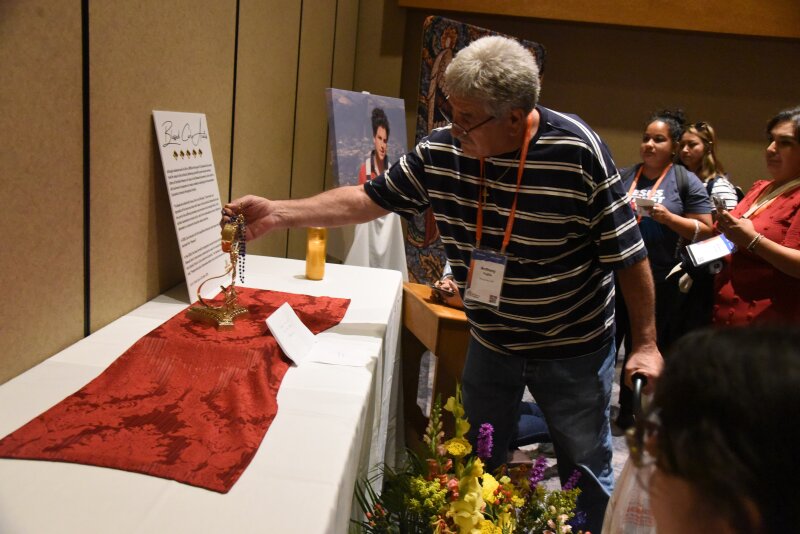
Despite long wait, chance to venerate saints’ relics offers ‘graces’ for congress-goers
By Sean Gallagher, OSV News
07/29/2024
INDIANAPOLIS (OSV News) — The line to enter the relic chapel at the National Eucharistic Congress snaked a long way through the Indiana Convention Center while the event took place from July 17-21.
Congress attendees seeking to venerate the relics of several saints at times stood in line for an hour, two or more.
Yet it was all worth it for Anthony Trujillo of Albuquerque, New Mexico, even though he walks with a cane and experiences pain due to chronic arthritis and the ongoing physical effects of a head-on collision driving a motorcycle he suffered decades ago.
Because of his health challenges, Trujillo knows personally the power of prayer.
"Relics are very special," he told The Criterion, Indianapolis' archdiocesan newspaper. "When I saw that there were relics here, I had to come to see them and pray to the saints. Maybe they'll help me with my body, too. It's very meaningful for me. That's why I stood in this line with this pain."
Saints and blesseds whose relics were available for veneration in the chapel included the four patron saints of the National Eucharistic Pilgrimage: the Blessed Virgin Mary, St. Juan Diego, St. Elizabeth Ann Seton and St. Junipero Serra. The relic of Mary featured in the chapel was part of her veil.

reliquary holding a relic of Blessed Carlo Acutis July 19, 2024, in the
relic chapel of the National Eucharistic Congress at the Indiana
Convention Center in Indianapolis.
OSV News photo/Sean Gallagher, The Criterion
Joyce Ricke, a member of St. Catherine of Siena Parish in Decatur County, was especially looking forward to venerating Mary's veil.
"It's as close as I will ever get to her on this earth," she said. "I feel like in my heart I will receive graces by being in the presence of the veil that she wore herself."
Kneelers were set before each of the relics for prayer. People venerating them were allowed to place items such as rosaries or prayer cards, against the reliquaries that held the relics, thus making them into what are known as third-class relics.
Other saints whose relics were on display included St. Pascal Baylon, a 16th-century Spanish Franciscan who is the patron saint of Eucharistic congresses, and a saint and soon-to-be-saint who showed a great love of the Eucharist during their lives: St. Manuel Gonzalez and Blessed Carlo Acutis.
Blessed Carlo, whose future canonization has been approved by Pope Francis, is known as the first millennial saint.
An Italian, he died of leukemia at 15 in 2006. He showed great faith from a young age and was unafraid to encourage it in his friends and even his parents. Blessed Carlo also had such a deep love for the Eucharist that he developed a website that documents Eucharistic miracles from around the world and is known for saying, "The Eucharist is the highway to heaven."
Mariana Noch, 17, of Pinckney, Michigan, spoke while waiting in line of how she appreciates Blessed Carlo and wants to be more like him.
"I liked the way he would bring friends to adoration," she said. "He loved the Eucharist and also loved his friends. He would show them his love for the Eucharist."
Mariana's brother Kolbe, 21, shared her admiration for Blessed Carlo.
"He had no fear of what people thought or any of the anxieties that you normally see," Kolbe said. "I want to embrace other people (like he did). Sometimes, I want to talk to everyone. I want to bring them to Jesus. But then there are times when I wonder if they're going to think I'm weird."
St. Manuel, a Spanish bishop who died in 1940, is known as the "bishop of the abandoned tabernacle," because of an experience he had as a newly ordained priest. He was assigned to preach a mission at a parish where parishioners had largely walked away from their faith, even to the point where there were cobwebs on the parish church's tabernacle.
This made St. Manuel realize the sadness of Christ when he is abandoned by his people and led him to encourage a deep eucharistic spirituality in others for the rest of his life. This included him founding in Spain an order of religious sisters dedicated to this work, the Eucharistic Missionaries of Nazareth.
Sister Monica Mariel Yuan Cordiviola and other members of the order accompanied relics of St. Manuel to the congress. Among them were first-class relics (parts of his bones) and possessions of his, known as second-class relics, that included a chasuble and zucchetto (a bishop's skull cap).
She was overwhelmed by seeing the number of people making their way to the relic chapel.
"I have no words," Sister Monica said. "We are so excited and so happy. For us, it's like a miracle. It's a gift that shows us that St. Manuel wants to be here with the Catholics of the United States."
She noted that the spirituality of St. Manuel and her order were in harmony with that of the three-year National Eucharistic Revival promoted by the U.S. bishops.
"Many people might think that the Eucharistic Missionaries might be all day praying in perpetual adoration," she said. "And that's OK. We pray. But our charism is not only to pray. It's also to 'Eucharisticize' (the world). It's a word that St. Manuel invented and means to announce that Christ is before us in the Eucharist.
"That's what the bishops in the U.S. are saying. The bishops of the United States in the last year of the Eucharistic revival want every Catholic to become Eucharistic missionaries."
-
